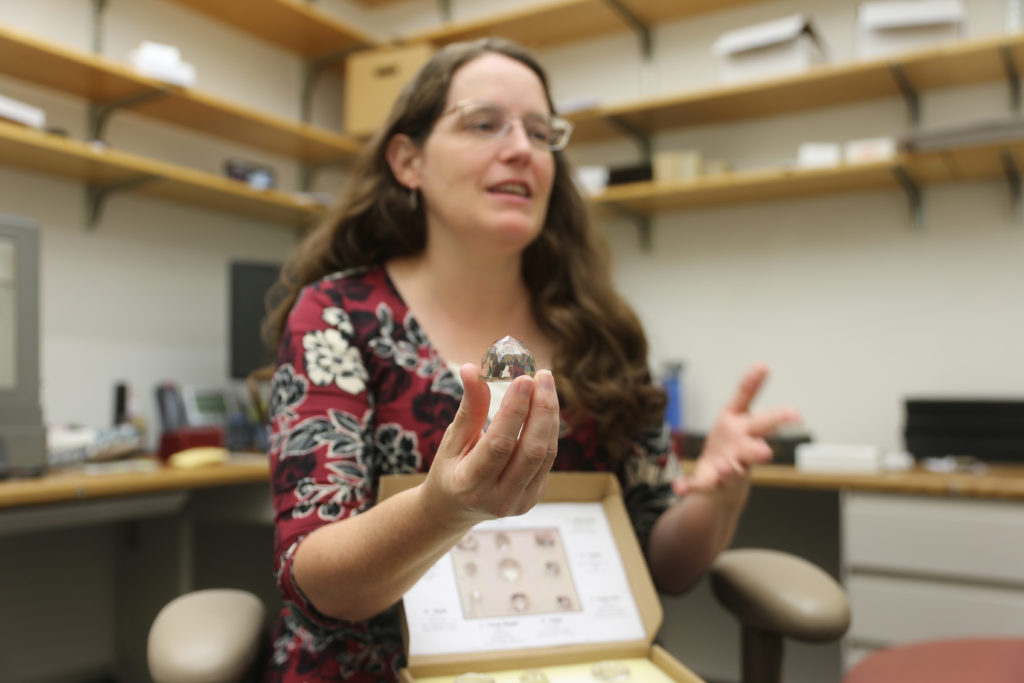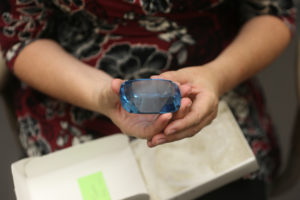Growing up, Keryn had never heard of the word “geology.” But, years later she has a master’s in geology and is a BYU geology adjunct professor.
Keryn’s geology venture began in 1999 with her BYU bachelor’s degree in geology, going on to a master’s in geology at BYU immediately after. However, she got married and started working full time before she finished her thesis. She taught introductory geology courses at UVSC, now Utah Valley University. In 2014, Keryn came back to BYU to restart and finish her master’s program, graduating in 2015.
Keryn was hired to teach the introductory geology course at BYU a week before the Fall 2015 semester began and has been teaching at BYU since. In Winter 2018, she started developing a course teaching about diamonds and gems, which is waiting for approval to be a general education course.

BYU adjunct geology professor Keryn Ross holds a glass replica of the Great Mogul Diamond. (Ty Mullen)
Currently, her time is spent developing the gem course and doing research to get a paper published on the Cottonwood Wash Tuff supervolcano that erupted 30 million years ago on the Nevada-Utah border.
Listen to an audio clip of Keryn talking about her research on the supervolcano.
![]() “If I’m conscious of my time,” Keryn said, “I end up having enough time to do the things I need to.” She also depends a lot on her older kids to help with chores around the house.
“If I’m conscious of my time,” Keryn said, “I end up having enough time to do the things I need to.” She also depends a lot on her older kids to help with chores around the house.
She has never “stopped being nervous” about working as a mother. She has learned that when she is with her kids, she needs to be with her kids — talking, listening and spending time with them.
Although she sometimes feels bad about working, Keryn hopes as her kids see her doing something she loves, that example will help their futures.
“We wanted our kids to see that you can work hard to get the things you want and still be able to do the things the Lord wants you to do, like be home with the family.”
Most of Keryn’s work can be done at home too, meaning she only comes to BYU about twice a week. While doing her master’s degree, Keryn said the geology department was very flexible in helping her balance her studies and family life.
“It doesn’t hurt to have the kids realize that mom has to do hard things too, that life is not all peaches and cream and lovely when you’re a grown-up.”
Keryn said she used to feel sorry for people who worked outside the home. She said for some it’s sad because they work out of necessity and not desire, but her perspective has changed.
“My whole life I grew up thinking that I would be home with my kids all the time, and then it turns out that maybe that’s not the best choice for me.”
While in primary and secondary school, Keryn said all her teachers were women. All the doctors and dentists were men. Out of her friends, Keryn said most of their mothers were stay-at-home moms. The few who weren’t, were secretaries, nurses or teachers.
“Those were the roles,” she said. “It was very typical.”
Keryn said her parents always supported her aspirations, but she didn’t have that role model of a female scientist.
“It was really hard for me to be OK with the idea that I wanted to be a scientist,” she said.
Keryn said at BYU maybe 20–25 percent of the geology students were female. That number “exploded” during her master’s, up to 50 percent — although there still weren’t female geology professors at BYU at the time.

BYU adjunct geology professor Keryn Ross holds a topaz, the Utah state gemstone. (Ty Mullen
However, Keryn said the geology department has been supportive of women, helping them manage their studies and family life.
“They’ve been nothing but supportive,” she said. “But having a role model, I think, actually makes a really big difference. Because then you can look at it and say, ‘This is what her life looks like. I’d like my life to look like that but with these changes.'”
Although there are male role models in geology, Keryn said with children and family life, it’s nice to have a same-gender role model comparison.
She explained this idea as a “feedback loop.” The more role models there are, the more girls will look at those roles as attainable.
“There are ways that we need to be supporting mothers more and families more, not just the mothers but the fathers too.”
Keryn said, for her, having those role models is important. She said it would be less “anxiety-inducing to be able to see that other people are making it work.”